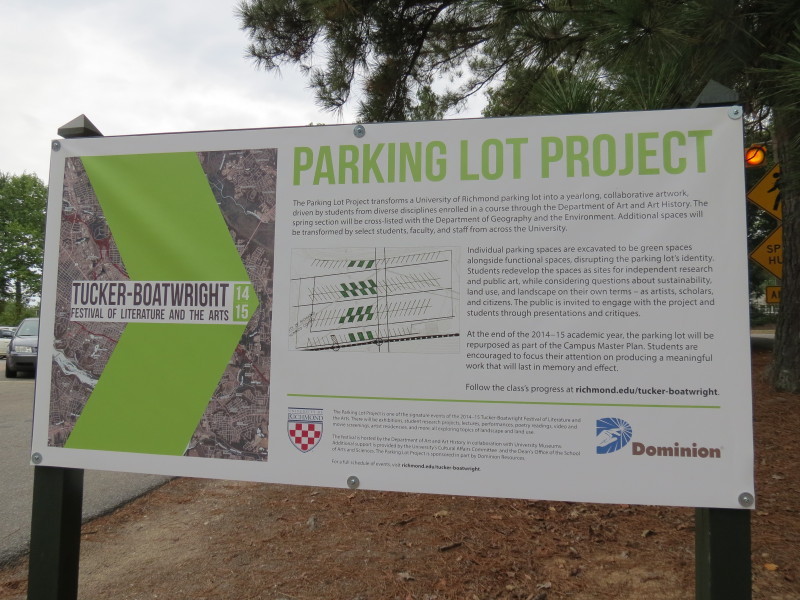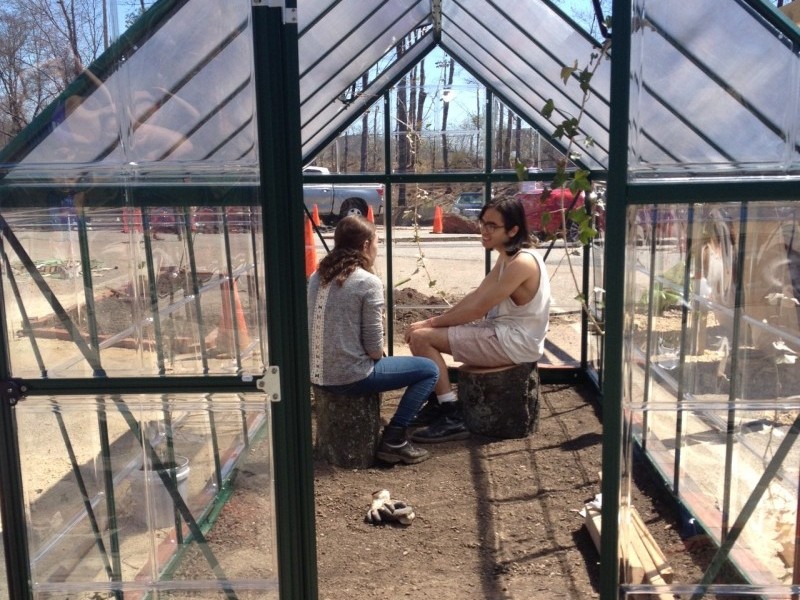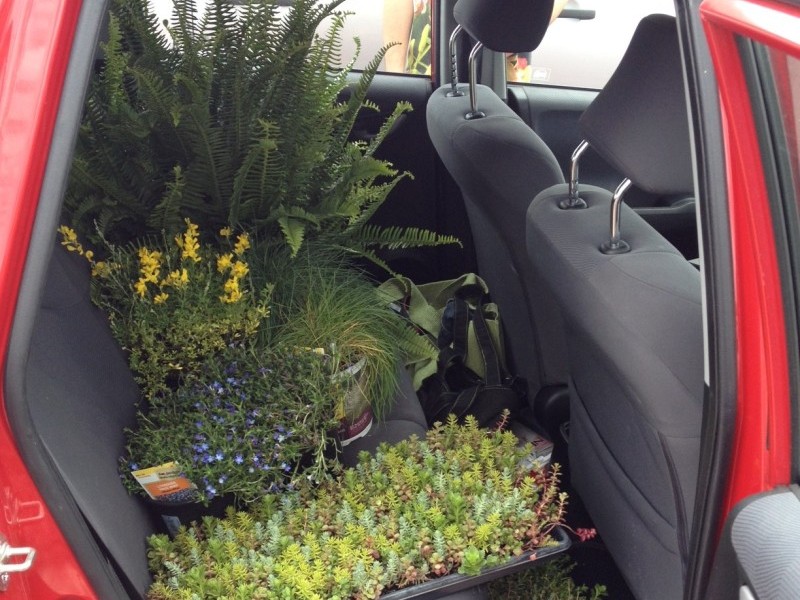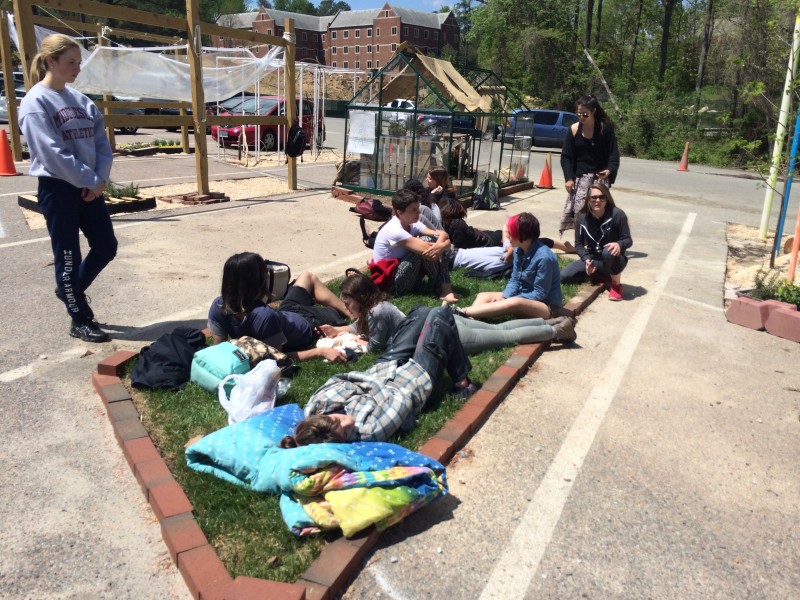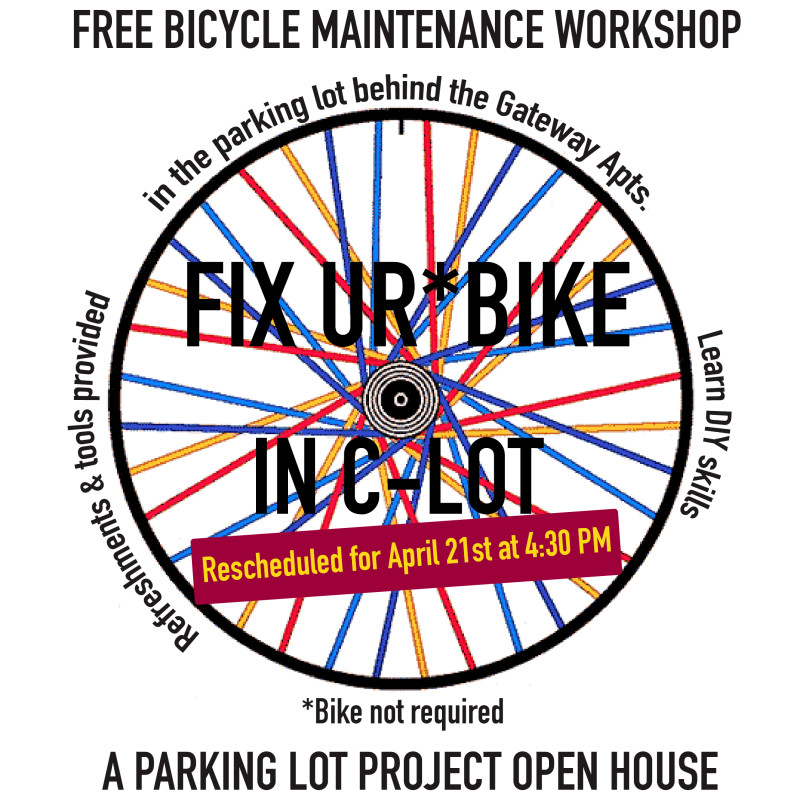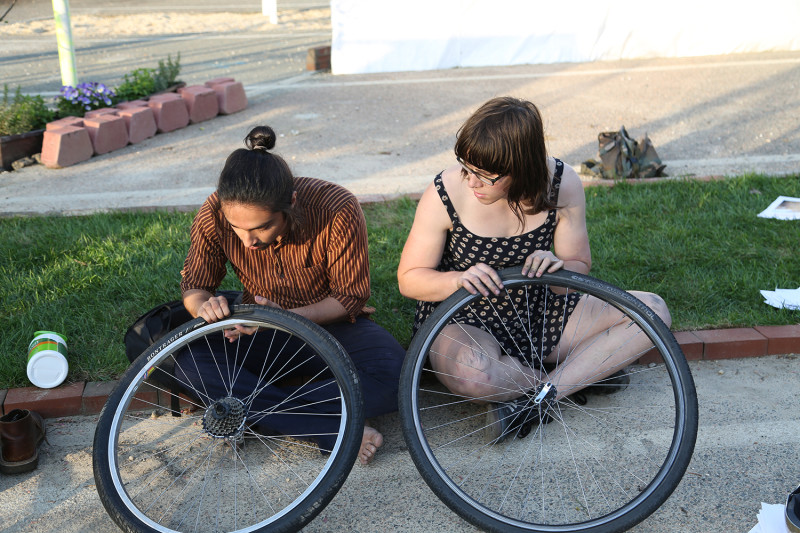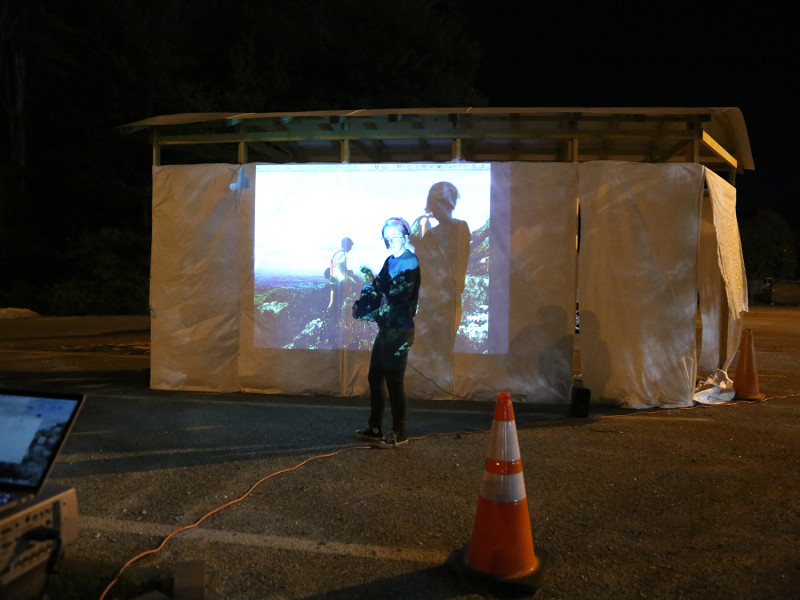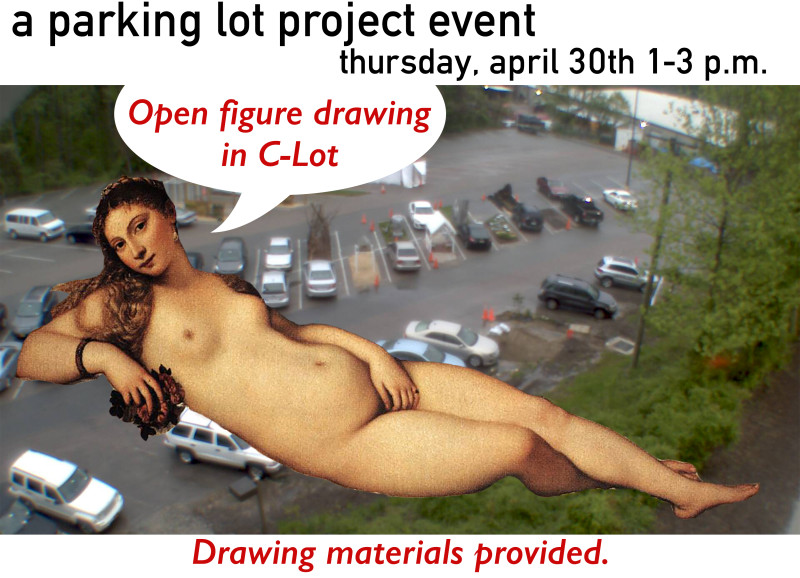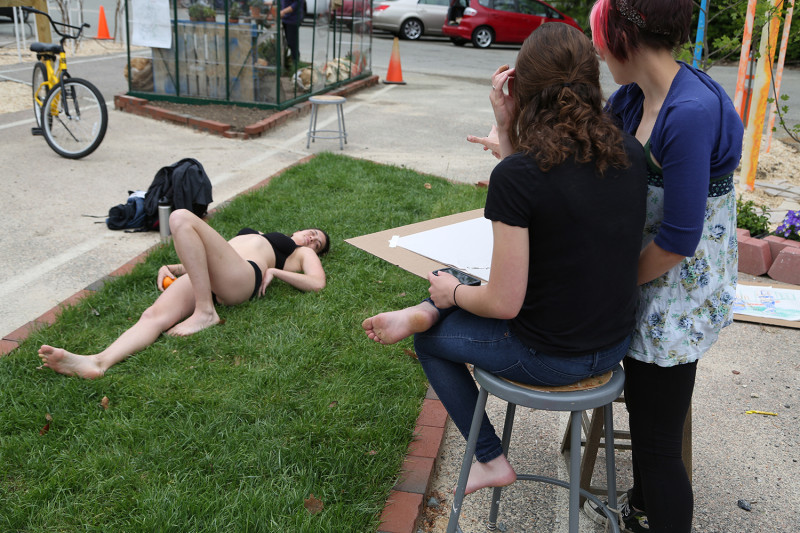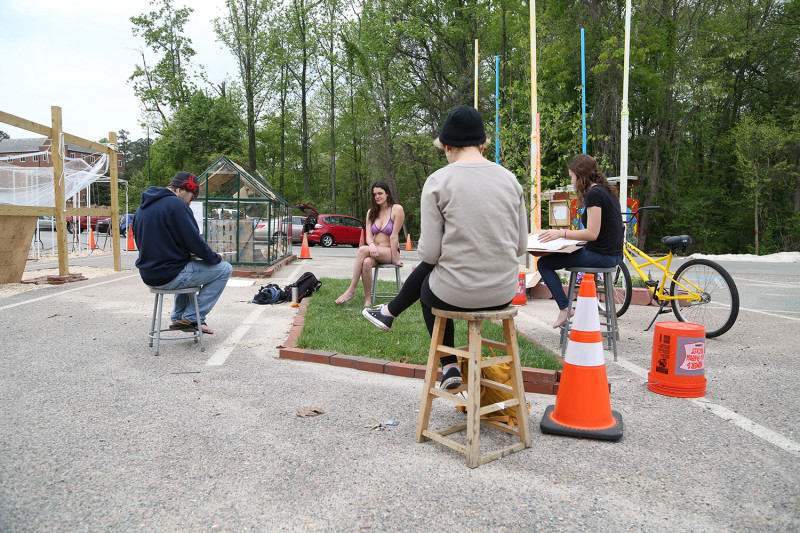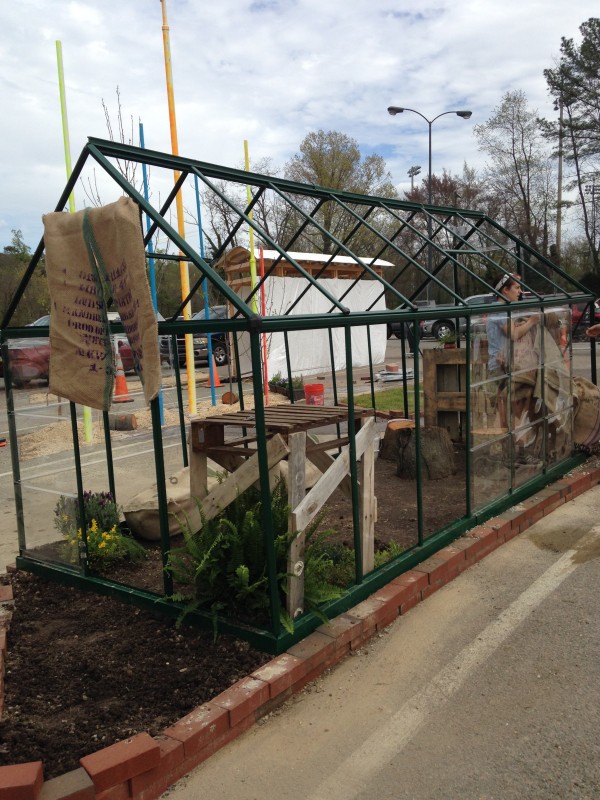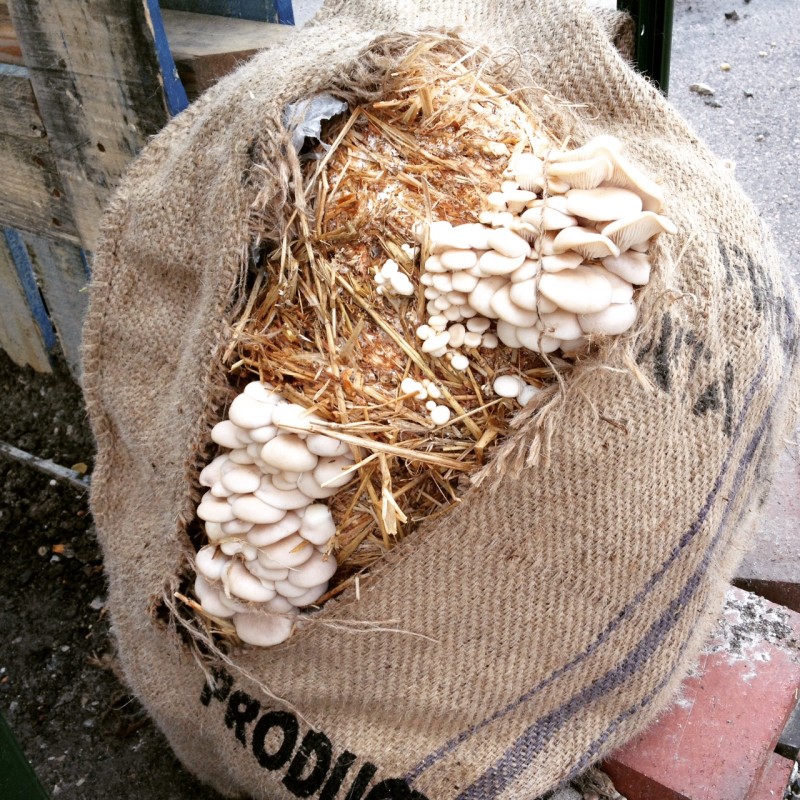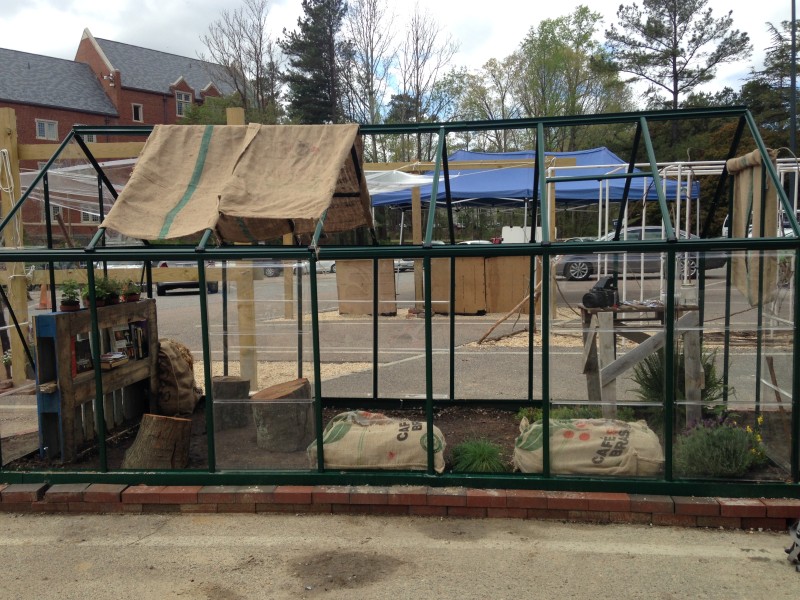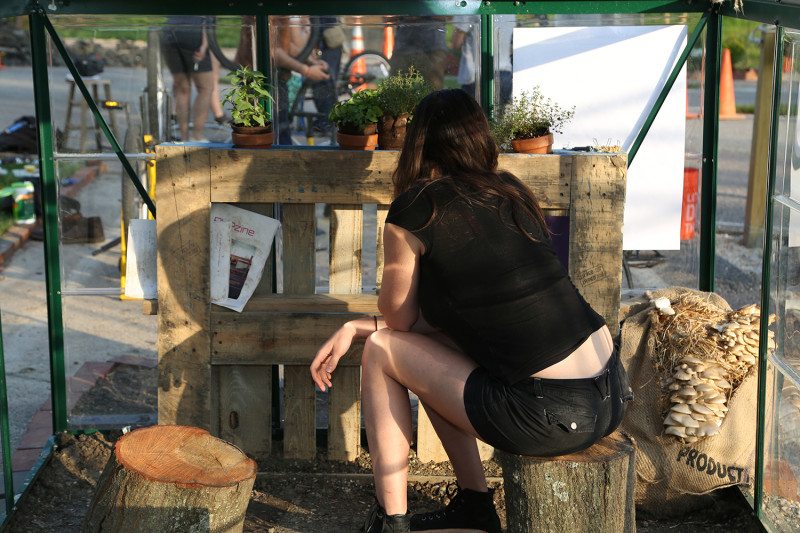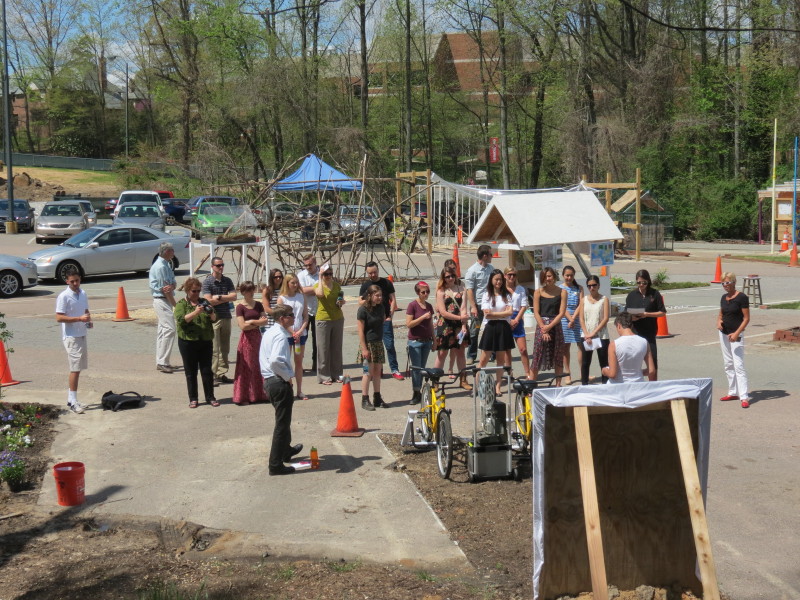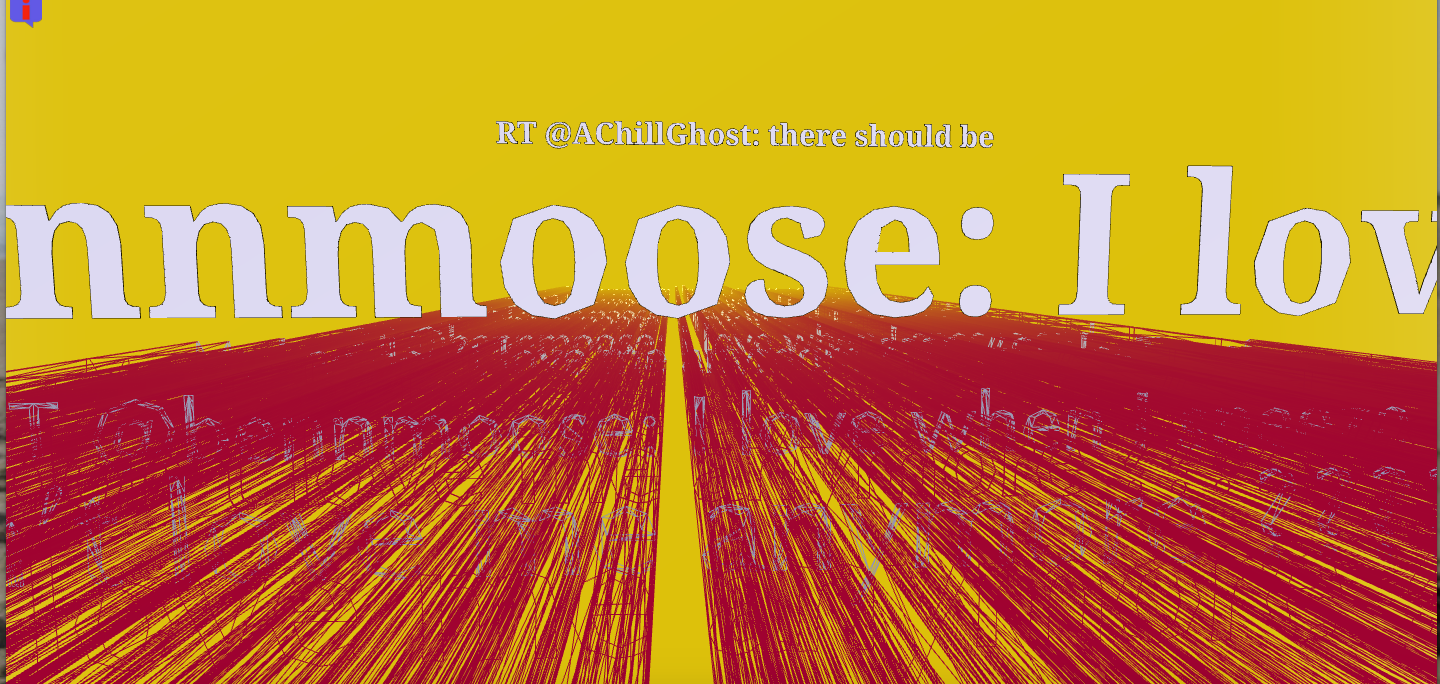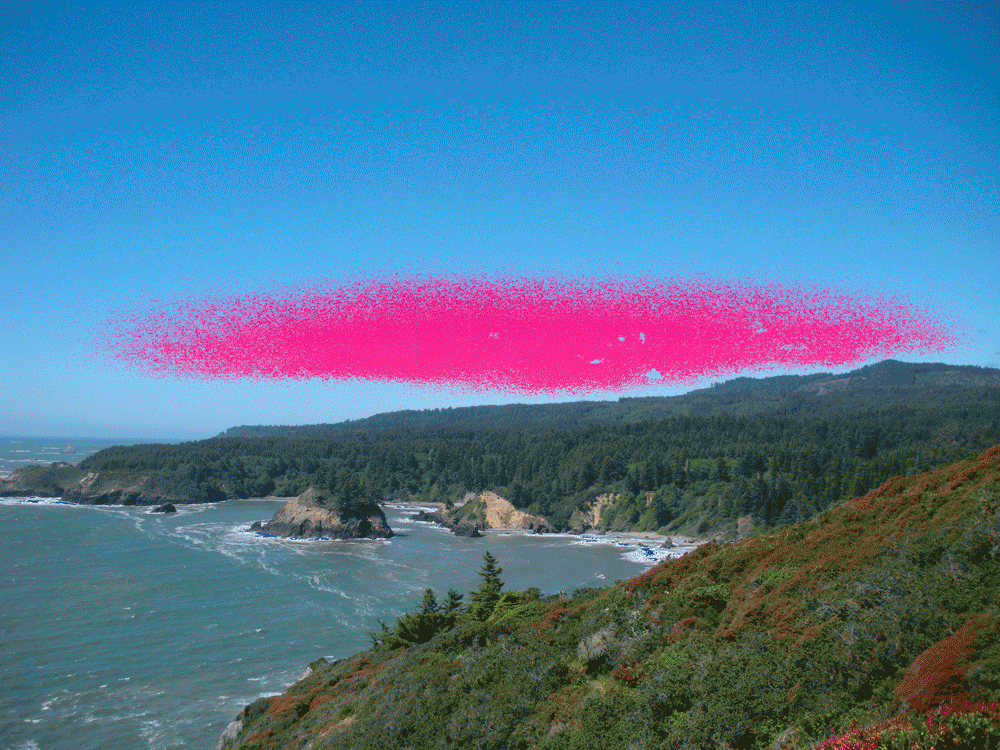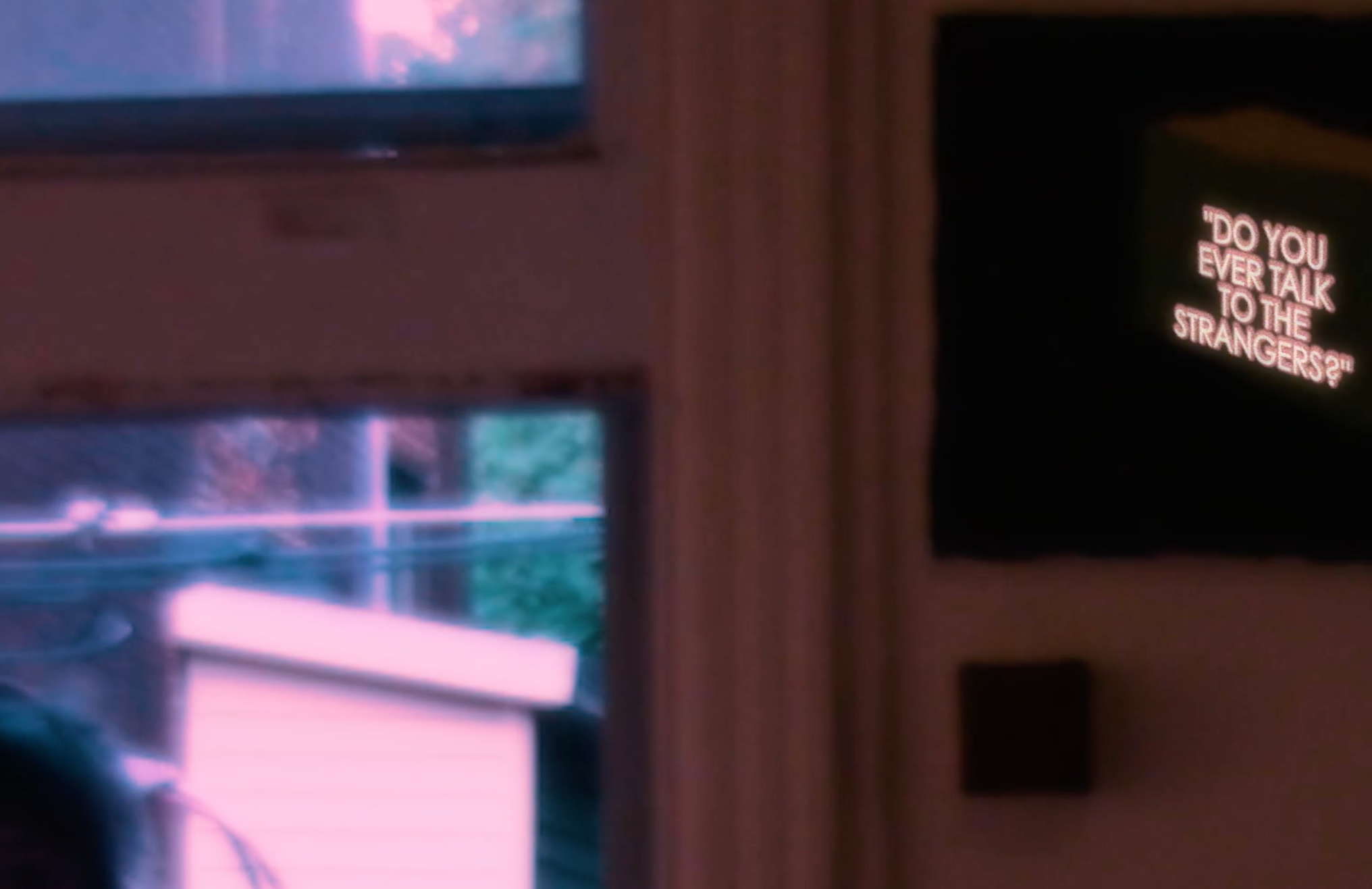::
Dig a hole.
Shovel the dirt into a wheelbarrow.
Dump the dirt back into the hole.
::
Contemplate loss on a stump.
::
Find two people you love.
Build a perfect space.
When it falls down, try again.
::
The Parking Lot Project, a yearlong course led by Professor Erling Sjovold, was a multi-media art installation in the University of Richmond C-Lot parking lot. The project transformed the campus parking lot into a yearlong site-specific outdoor art exhibition. Excavated parking spaces were redeveloped as green art spaces alongside functional spaces for cars, disrupting the parking lot’s identity and cultivating space for critical and creative inquiry.
We all stumbled into the Parking Lot Project in different ways: Kenta joined through curiosity and a longing to create after a four-year focus on art history. Izzy bounded into the project as an enthusiastic artist and avid nature lover. And Miranda meandered into the Parking Lot Project as an oral historian, looking to collect stories and discovering that parking lots are full of them. Finding ourselves together in this parking lot, each with our own ideas, our own intentions, and our own experiences, we joined together to create a collaborative greenhouse nestled inside of a single parking space.
Told through the words of our post-project reflections, this is the story of our greenhouse:
Humble Beginnings
“At the beginning, our collaboration was very much about the creation of an empty, open space with potential to change the campus culture; however, filling the space with work was still individually focused. We wanted to combine our individual forces to engage with the public, creating a space that had the possibility to change and influence a wider audience.” –Miranda
“As soon as I started collaborating with Izzy and Miranda I recognized I would have to ditch my cynicism and learn to ride their excitement and optimism for the project to succeed. We began thinking of the parking spot as a public, inside-out exhibition space. Anchored by Miranda’s oral history project – which was to be displayed on the outside walls of the space – we wanted a rotating display of artworks that examined the meaning of the parking lot, environmentalism and land use, and public art’s ability to enact change. For me, ideas ranged from sculptural works exploring the aesthetics of permeable and impermeable materials, to the growing of mushrooms atop mounds of gasoline-saturated soil. While we were thinking of the space in an unstructured, flexible way, in retrospect, my ideas were all very product oriented. I didn’t want to make one definitive statement; I wanted to make many.” –Kenta
“Originally, the greenhouse existed within the parking lot in opposition to everything parking lots conventionally stand for. We wanted to erect a site that fully acknowledged and worked against its surroundings. In a manner of radical protest, the space would exist in the non-site of a parking lot and would foster social interaction, listening, and learning. The greenhouse meant a lot of different things for the three of us who collaborated on it: a space to tell stories, to share art, and to promote real engagements within a barren space. Our ideas were unified under the one tenant: everything we wanted to do would alter how people interact with the space, and challenge perceptions about how one spends time in the a parking lot.” –Izzy
“As we worked in the parking lot, both in class and out, we began to realize how performative the nature of the class was. Whether it was screwing panels into the greenhouse’s roof in the blazing sun or attempting to move dirt from one space to another in the freezing cold, the project as a whole seemed intimately tied to the absurd. What was powerful about this realization was the realization that came with it: as absurd as it all was, we were doing it, and we were doing it because we believed in what we were doing.” –Kenta
“As we worked week after week in the parking lot, we eventually began to see the environment as something not completely outside of our greenhouse. The process of building and spending time in the greenhouse made the parking lot seem a part of it, despite the stark juxtaposition between the two. The greenhouse arrived at a place of existing as a part of a narrative that includes the parking, and not in opposition to it. Above all else, the greenhouse became a habitation that required collaboration and community to exist.” –Izzy
The Fall and The Art of Failure
“Just as we tightened the final bolt to the greenhouse, a the product of many long hours of work, and began to conceptualize ideas for using the space, our greenhouse blew down. It was shattered, torn apart, and smashed by the wind. Yet, as Kenta, Izzy, and I came running down to the parking lot to survey the damage, we felt a strange sense of calm as we entered the parking lot. Our broken greenhouse lay strewn across the asphalt, yet there was a sense of collectivity that we had not felt as intensely before: a crowd rallied around our space, trying to minimize damage and help us rebuild it again.” –Miranda
“Understanding our project as a process became particularly evident after the greenhouse, which was freshly completed, blew away with the wind. All the hours of instruction-following – and the beautiful, near-perfect result – suddenly became irrelevant. In its place we found a circle of facilities staff, helping before we’d even gotten there. We found Nathan, the studio manager, who was quick to assure us it would all be okay. We found ourselves, sitting on our remaining three stumps in utter disbelief. More than ever before, the project felt less about a finished product and more about the community that comes out of the process. It shifted our focus away from wanting to have something to show the campus to an embrace of the beauty discovered in reaching towards the unreachable and the relationships that can be built through the effort.” –Kenta
“With our perfect collective greenhouse destroyed, we found another community. Our project sought to discover and develop a collective energy within the context of the parking lot, and, ironically, with its collapse we had achieved that goal.” –Miranda
“The idea that something we worked for had failed liberated us from the tight structure of our original plans. It opened up our process and revealed the meaning of the greenhouse as it evolved. I don’t think any of us imagined the intimacy created from the labor of the project; digging holes, shoveling gravel, and picking up the bent remains of our greenhouse. We would continue to facilitate the alternative use of the space for social engagements, but in the end the greenhouse ultimately became the reflection of the more private collaboration between the three of us.” –Izzy
“Originally, we had envisioned a perfect structure within an imperfect space—a perfect greenhouse within the imperfect and problematic context of the parking lot. Building the greenhouse was about reaching a form of perfection. All the parts had to fixed together exactly, we had to follow the directions precisely, the space around it had to be clean and manicured, etc. Nature’s destruction of our ‘perfect’ greenhouse created space for us to reevaluate what failure and what perfection mean.” –Miranda
“At the time of the collapse, I happened to be reading the book Cruising Utopias by Jose Esteban Munoz and was deeply impacted by his queering of success. His understanding of queerness, at least for me, has little to do with sexuality or gender, and has everything to do with utopia. His point is that queerness (or utopia) will never exist, and with this understanding we must accept that utopic thinking is inevitably followed by failure. He suggests that the definitions of success in our society are not written for us, and that in order to create meaningful change we must accept an aesthetic of failure. While the three of us sat on our stumps, I came to see such an aesthetic throughout the parking lot. In an unhospitable environment, both culturally and physically, our class was willing to be both earnest and absurd. With this in mind, we reconstructed our greenhouse.” –Kenta
Discovering Our Own Utopia
“Leaving our three stumps in the center of our space, we began to rebuild. We chose to leave some of the panels out, creating space for people and nature to enter our space from all sides. Interested in bioremediation stemming from Mel Chin’s Revival Field, we placed mycelium-inoculated burlap bags in the greenhouse. The oral histories, integrated with soundscapes of parking lot sounds, serve as a reminder of complexity of the parking lot as a transitory space that has roots deep in cultural memory. The parking lot stories remind us that the parking lot has the potential to be, ultimately, as intimate a space as one makes it. With the oral histories sound piece playing, the smell of the mushrooms and plants, and the invitation to sit on the stumps and enjoy the space, intimacy and a sense of collectivity simultaneously permeate through the greenhouse. As we host events in the parking lot from bicycle workshops to figure drawing, screen films, and produce zines to document our experience, we no longer felt a need to force people into the parking lot.” –Miranda
“I think because of the intimacy of these revelations, within the confines of the greenhouse our project became pretty squarely about us. Through the trials of the project we began to feel intimately connected to the space, for without it we wouldn’t be friends. We began meeting on our three stumps, writing event scores for future zines and planning workshops for class. Outside the time frame of our class the parking lot came alive. As sorority members would pass by, drunk wearing heels on their way to a social, we realized how liminal the parking lot truly is. Huddled together we felt invisible, but invisible in the sense that the connection we shared was too strong to be shared. At the class’s onset I considered creating a space for reflecting on the environment; I wanted something as visually impactful as Roni Horn’s Library of Water. Instead I think we creating something more similar to Vaughn Bell’s terrariums. Upon entering the space we want viewers to feel something both foreign and familiar. We want viewers to sense something palpable. Through the audio of people’s personal stories, the smell of the plants and the mushrooms and the traces of our hard work, we want people to sense something urgent, even if they can’t quite discern what it is for.” –Kenta
“As we rebuilt the greenhouse, we began to understand that the persistent attempt to create an idealistic space results in a different kind of perfection. In one sense, it creates an intimate, relational perfection between those who reach again and again towards an idealistic goal. In another sense, the broader interaction with the sincerity of a failed space being rebuilt creates an opportunity for discussion and interaction among a broader community. As we rebuilt the greenhouse, we sought to embrace the absurdity of reaching for perfection within its inevitable failure.” –Miranda
“The absurdity of how we have presented ourselves in the context of the parking lot is a quiet assertion against the status quo. The experience we’ve had engaging with the Parking Lot Project does not end here. It will continue to manifest itself in the way that we will continue to demand student-run spaces and alternative ways of land-use that foster social interaction. The parking lot will live on long after it has been demolished.” –Izzy
“From interaction, listening, and learning, we made noise in a quiet way, drawing people to our space through our sincerity and their genuine interest to be part of our experience. Some feel as if our parking lot project is an intrusion, and that’s okay. Its controversial nature is part of the discussion. We believe that our genuine love for this little greenhouse in this parking lot can change others just as it has changed us—slowly, organically opening up an original space for a community that hungers for creativity and complexity in order to to explore themselves and their place in the world.” –Miranda
A virtual exhibition of our completed greenhouse:
This hour-long oral history based sound piece was created from interviews done by Miranda Rosenblum, telling the stories and experiences from parking lots around the world. Interersperced with parking lot sounds collected by Izzy Pezzulo, this sound piece draws into question the cultural assumption of insignificance of parking lots in the lives of those who interact with them. This sound piece is intended to be played on loop from inside the greenhouse.
:::
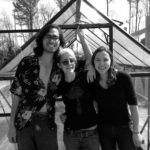
Kenta Murakami is a University of Richmond graduate with a major in Art History. He currently lives in New York City working as an intern for Hauser & Wirth, writing nuanced art reviews for Hyperallergic, and drinking too much espresso. Izzy Pezzulo and Miranda Rosenblum are both still students at the University of Richmond and spend their time exploring RVA, listening to femme punk music, and wreaking havoc. Kenta, Izzy, and Miranda keep their intimate friendship alive through invigorating phone calls and email exchanges filled with digitally minded articles and bizarre gallery simulation links.

